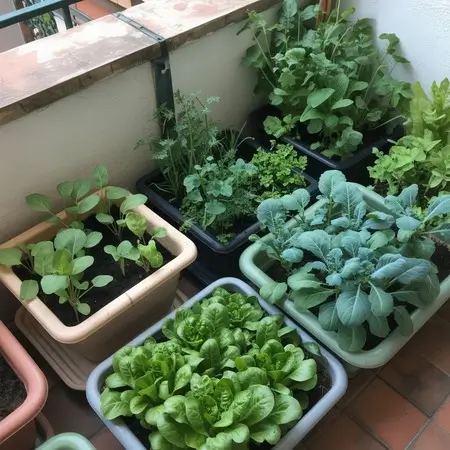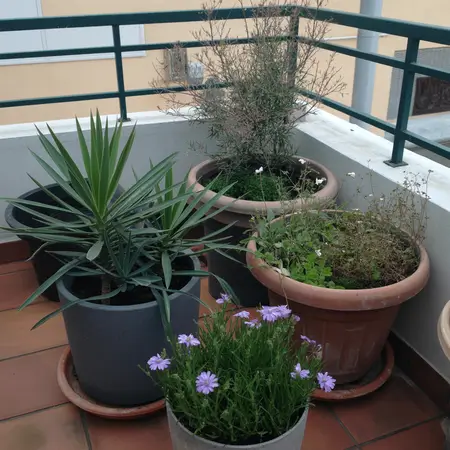Practical Terrace Garden Ideas for Fresh Daily Harvests
A terrace garden is a great way to grow your own food and plants even when you don’t have land.
Your rooftop can become a space that feeds your family, saves money, and keeps you close to nature. The best part is you don’t need fancy setups.
Just simple ideas, a few containers, and the will to grow. Below are some useful terrace garden ideas you can try.
1. Vegetable Terrace Garden
One of the easiest ways to use a terrace is for growing seasonal vegetables. You can plant tomatoes, chilies, okra, spinach, and beans in pots or grow bags.

These crops don’t need too much space and grow well with basic care. Rotate the crops every season so the soil stays healthy and you always have something fresh to pick.
Growing your own vegetables means fewer trips to the market and more control over what you eat.
2. Terrace Herb Garden
Herbs are quick to grow and add flavor to food. On your terrace, you can keep a small section just for herbs like mint, basil, parsley, coriander, and lemongrass.
They grow fast and don’t take much space. You can even use small pots, recycled containers, or railing planters. Having herbs ready on your terrace saves money and adds freshness to your daily cooking.
Plus, many herbs smell great and can keep your terrace green all year round.
3. Fruit Terrace Garden
If you want a bigger harvest, try growing fruits on your terrace. Dwarf or container-friendly fruit trees like lemon, guava, papaya, or pomegranate are good choices.
You can also grow strawberries in pots or hanging baskets. Fruit plants need a bit more care and patience, but once they start producing, they give steady yields.
Imagine walking to your terrace and picking fresh lemons or guavas, it’s a rewarding experience.
4. Terrace Grain and Pulse Garden
Most people don’t think of growing grains or pulses on a terrace, but it is possible on a small scale. You can grow wheatgrass for juices, lentils in containers, or chickpeas in wide pots.
These crops may not give large harvests, but even a small yield feels special.
It also helps you understand how staple foods are grown. This idea is perfect if you want to experiment or teach kids about farming at home.
5. Spice Terrace Garden
Spices are part of daily cooking, and many of them can be grown on your terrace. Plants like ginger, turmeric, garlic, and chilies can grow well in pots or grow bags.
They don’t need too much space, but they do need time to mature. Fresh turmeric or ginger straight from your terrace adds strong flavor to food.
Having your own spice plants also means you always have some natural ingredients handy.
6. Leafy Greens Patch
Leafy greens grow very quickly and can be harvested again and again. On your terrace, you can grow lettuce, kale, mustard greens, fenugreek, and spinach in shallow containers.

They don’t need deep soil and are ready to harvest in just a few weeks. You can cut the leaves and let the plants grow again.
A leafy greens patch is great for salads, stir-fry, and daily cooking. It’s one of the easiest terrace garden ideas for beginners.
7. Root Vegetable Garden
Root vegetables need deeper containers, but they are worth the effort. Carrots, radish, beetroot, and sweet potatoes grow well in grow bags or buckets with enough soil depth.
These plants give a good harvest and taste much fresher than market produce.
Root vegetables are also hardy and don’t need too much daily care once planted. Having a terrace root garden means you can pull out crunchy carrots or sweet beets whenever you need them.
8. Medicinal Plant Terrace Garden
Plants are not only for food some are used for natural remedies too.
On your terrace, you can grow aloe vera for skin care, tulsi (holy basil) for tea, neem for natural protection, and moringa for its nutrient-rich leaves.
These plants don’t just look good, they are also useful in daily life. A medicinal terrace garden can give you natural healing options without needing to buy from stores.
9. Climber and Vine Garden
Some plants grow better when they climb or spread. On your terrace, you can use supports or trellises to grow bottle gourd, bitter gourd, cucumbers, and beans.
These plants save space by growing upward and also give heavy yields. Gourds and beans grow quickly and can keep producing for months.
A climber garden also gives your terrace a green cover, but most importantly, it provides fresh vegetables for your meals.
10. Mixed Terrace Garden
If you can’t pick just one type, mix them all. A mixed terrace garden has vegetables, fruits, herbs, and maybe even medicinal plants all growing together.
This way, you can harvest something in every season. Mixing plants also helps the soil and reduces pests. For example, growing basil near tomatoes can help repel insects.
A mixed garden is perfect for families who want variety in their food straight from the terrace.
11. Gardens for Native Plants / ‘Nativars’
Native plants are those that naturally grow in your local area. They are stronger, need less water, and are easier to care for.

On your terrace, you can choose nativars plants bred from native species, so they grow well without much effort. This makes your terrace garden more resilient and less time-consuming.
Plus, native plants often support local pollinators, which helps the environment too.
12. Low-Water / Drought-Tolerant Terrace Gardening
If your terrace gets very hot or water is costly, try drought-tolerant gardening. Pick plants that don’t need much water, like succulents, native grasses, or hardy herbs.
Use mulch and soil that holds moisture, and choose containers that reduce water loss. This type of terrace garden is easy to maintain and still gives you greenery without worrying about daily watering.
13. Plant Selection by Terrace Orientation
Not all terraces get the same sunlight. East-facing terraces get soft morning sun, so they are good for herbs and greens.
South-facing terraces get strong heat, so pick heat-tolerant plants like chilies or okra. West-facing terraces suit gourds and cucumbers, while north-facing terraces are better for shade-tolerant plants.
Matching plants with your terrace direction helps them grow stronger with less effort.
Final Thoughts
A terrace garden can be simple or detailed, but the key is to grow what suits your space and your needs. Start small with herbs or leafy greens, then expand into fruits, spices, or even medicinal plants.
The joy of picking fresh food from your own terrace is unmatched. Whether you have a small rooftop or a large one, these ideas can help you grow something useful and rewarding.
